AMD Radeon HD 6850 Overclocking Roundup: Asus, XFX, & MSI
by Ryan Smith on November 8, 2010 12:40 AM ESTOverclocking: Performance, Power, Temperature, & Noise
Half of our results focus on our 6850s at their stock clocks, but the other half of our results focus on the card when it comes to overclocking. As a lower clocked Barts card, 6850 cards not binned for poor maximum clocks should have a fair bit of overclocking room as AMD intended for the design to hit 900MHz+. The 6850’s power efficiency pretty much has to go out the window here, but in return we can capture some significant performance gains.
| Overclocking Results | ||||||
| Stock Clock | Max Overclock | Stock Voltage | Max Overclocked Voltage | |||
| Radeon HD 6850 Reference | 775MHz | 940MHz | 1.094v | 1.172v | ||
| XFX Radeon HD 6850 | 775MHz | 940MHz | 1.148v | 1.172v | ||
| MSI R6850 OC | 820MHz | 960MHz | 1.148v | 1.22v | ||
| Asus EAH6850 | 790MHz | 960MHz | 1.148v | 1.22v | ||
When overclocking, we found 3 things:
- All of the cards could hit 850MHz core at stock voltage
- All of the cards could hit 940MHz core at 1.172v, the 6870 load voltage
- We had to give the cards significantly more voltage to get above 940MHz. This culminated at 1.22v on the Asus and MSI cards for 960MHz
Based on these results we went ahead and benchmarked the Asus card at 850/1150, 940/1150, and 960/1150 to showcase the performance at these overclocks, while capturing data for all of the cards at 1.172v, and the Asus and MSI cards at 1.22v.
While it’s possible to hit 960MHz with enough voltage, in practice it’s not worth the effort. The Asus and MSI cards jumped in power consumption, temperature, and noise by around 20W, 3C, and 2dB each, for a performance difference of under 2%. On a higher-end card where performance is the only attribute that matters this wouldn’t really matter, but we would not consider this a useful tradeoff on a petite card like the 6850.
As for memory overclocking, we hit at solid wall at 1150MHz as none of our cards could do 1200MHz without artifacting. However 1150MHz didn’t trigger performance degradation due to error correction-induced retransmission, so it looks to be a safe frequency for all cards. The limit we believe lies solely with the memory controller, which was a conscientious decision by AMD to trade memory clocks for a smaller die. As a result the controller reaches its limit before we can even push the 5GHz GDDR5 to spec.
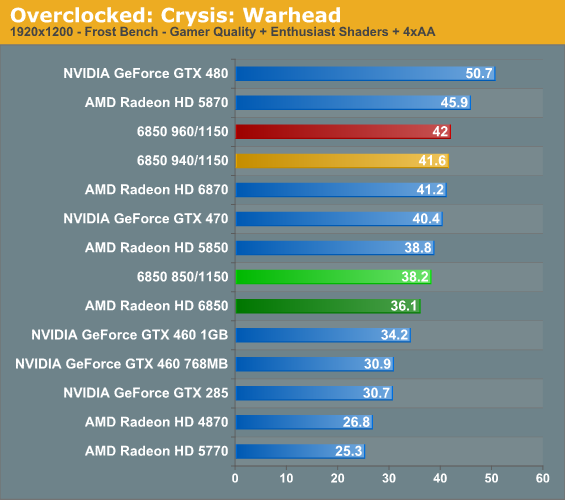
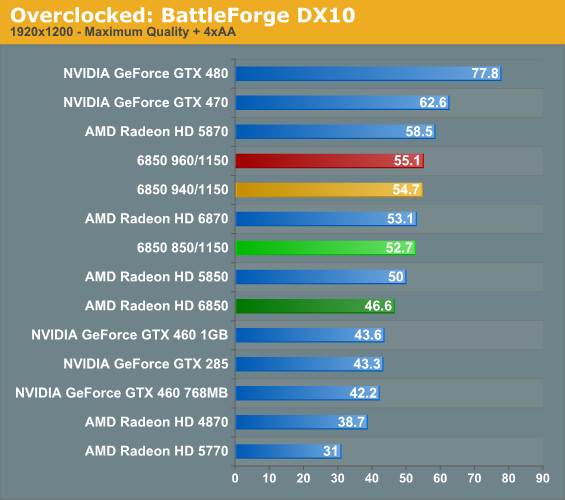


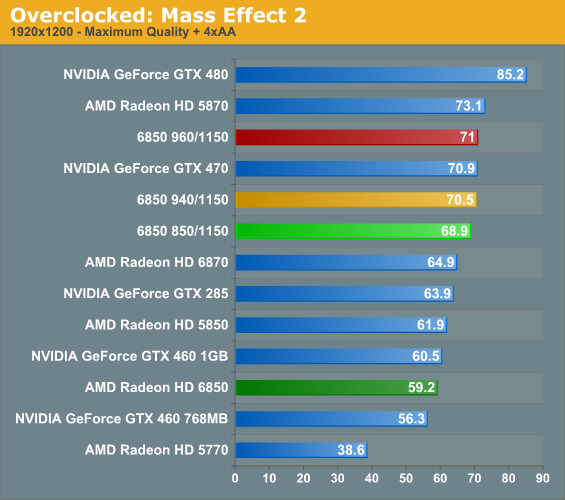
Something that caught us completely off-guard in our results is just how well the overclocked 6850 did. Even at the “mere” speed of 850/1150, it’s faster than the 6870 in 3 out of our 5 games; and the 6870 still has a core clockspeed advantage and more SIMDs! The advantage for our overclocked 6850s is that the memory clock of 1150MHz (4.6GHz effective) is faster than the 6870’s memory clock of 1050Mhz (4.2GHz effective), and this looks to be the reason for the difference. Based on all the data we have, Barts looks to be memory bandwidth starved in around half the games we use. From this it looks like a good memory overclock is going to go a long way on the 6850 and 6870 towards improving performance.
As for how much of an overclock is necessary, this depends on the game. When Barts is memory bandwidth starved, the 940Mhz and 960Mhz memory overclocks provide only a small boost; while on shader-bound games like Crysis there’s a very tangible benefit. Combine the memory overclock with a 940Mhz core overclock and the 6850 can meet or beat the 6870 every single time. The voltage increase necessary to achieve this core overclock comes at a price however.

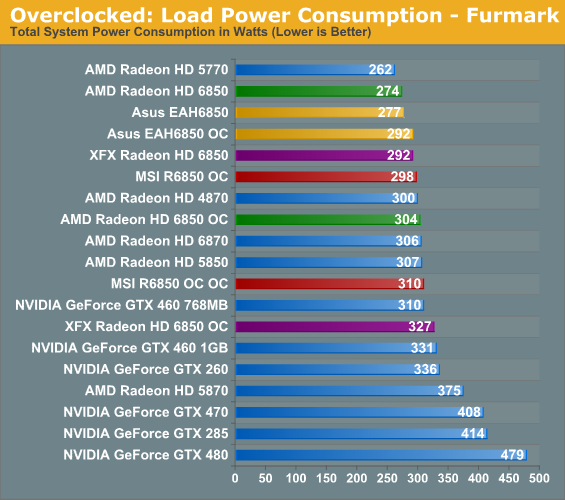
Starting with power consumption, the voltage increase necessary for 940MHz is around 20W-30W under FurMark for our reference and near-reference clocked cards, and less for the MSI card since it already has a notable factory overclock. If nothing else, 1.172v gives up all the power advantages over the Radeon 5850, though as we’ve seen it pays off with a very notable performance advantage over the 5850.
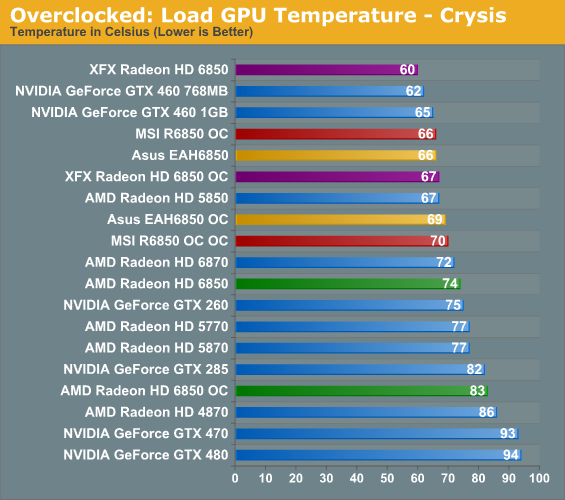

For the partner cards in today’s roundup, the temperature runup from overvolting isn’t too bad, with the worst card only hitting 81C under FurMark and becoming progressively cooler from there. However the reference 6850 is an entirely different story: it hits 93C under FurMark, which is hotter than what we’re comfortable with for Barts, particularly since it’s brand new. If reference-style cards show up on the market, we would not recommend overvolting them, at least not to 1.172v. Meanwhile the XFX card with its focus on temperature tops this chart, still only hitting 74C under FurMark. The cooling on this card is so good that we suspect the VRMs will burn up long before the GPU will when overvolting.
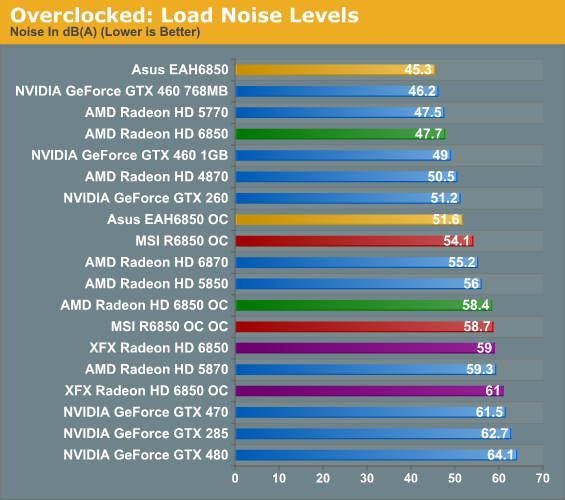
Finally we come to noise. We suspect many buyers will be alright with the power and temperature increases so long as noise remains manageable, so what we have is a mixed bag. Throwing out the reference 6850, we’re left with the XFX card at over 60dB, and while XFX’s focus on temperatures is commendable, it ends up being shortsighted by making the card exceptionally loud here. This is followed by the double-overclocked MSI card, which at 58.7dB is over 3dB louder than the 6870, but is only encroaching on the 5870. It’s too much noise for the performance, but compared to first-gen 40nm cards it’s not the end of the world.
This leaves us with the Asus card. While it does jump by 6dB due to our overclocking, it had such a massive lead at stock that this only makes it about as loud as the GTX 260 and Radeon HD 4870. The idea of a near-silent card has gone out the window at this point, but we would consider it a very manageable level of noise for the performance offed with the 940/1150 overclock. Certainly it’s the most balanced of the cards, as it sacrifices only little in the way of cooling (78C in FurMark) for the lower level of noise generated.










93 Comments
View All Comments
JPForums - Monday, November 8, 2010 - link
The EVGA GTX460 FTW used in the previous article can be found at newegg for $229.99/$239.99 (less $10 if you rely on MIRs).The cards in this article can be found at newegg for $184.99/$189.99.
Ignoring all the flak anandtech took for including the FTW card in the first place, you are still talking two different price categories.
While I'm in favor of comparing of including OC competition in an OC review, it isn't an absolute necessity.
Further, it would be irresponsible to compare cards in different price categories.
Given the variation in price from these OC units and how much they fluctuate, its near impossible to keep such an OC comparison relevant for long enough to be useful.
As such, I don't mind the lack of OC competition.
In fact, I think Ryan did a great job by focusing heavily on the AMD to AMD (6850 OC vs 6870 stock) comparison.
As long as the same rules apply when nVidia's new cards (stock and OC) come out, I see nothing to complain about.
7Enigma - Monday, November 8, 2010 - link
I disagree. Very few people are hard-capped at exactly X dollars. If I see that $20 more buys me 20% more performance I may just decide to shell out a bit extra coin. Taking this a step further, what is the point in including the GTX480? It's not even close to being in the same price category. It's used as a metric to show just what higher-end cards can do, and allows for the reader to quickly judge how long a past top-of-the-line part still has life before contemplating replacement with a middle-tier part.Personally to prevent muddying the charts I think one step above and below the price category (say +/- $50-75 for low/mid-range parts) is really all that is needed, but that SHOULD include the FTW. It's up to the reader to decide if the extra money, heat, noise, etc. is worth it for better performance. I do have to admit though that I like comparing my aging 4870 to the competition and it was nice to see it displayed in this review to remind me of the performance increase I could be seeing on my gaming system (currently game at 19" LCD so it's tough to justify as everything still plays great at that low resolution).
totenkopf - Monday, November 8, 2010 - link
7Enigma, read the title. If you are concerned with relative performance at given price points for the purpose of informed shopping, seek out articles similar to 'best graphics cards for the money' articles like Tom's runs. Also, criticizing their decision to include the 480 because of price seems irrelevant, they are measuring the performance of various 6850's as per the title, the rest of the cards are just simple reference.In this case, an additional $75 dollars represents around 40% of these cards initial cost. That's a pretty big extra expense. If i were in the market for a $20,000 car, I wouldn't see myself casually spending an extra $8,000 to take advantage of a deal. Presumably, this article is aimed at readers who already have decided on the 6850 and want to know more about those particular cards, not readers shopping different price points.
If Nvidia feels the OCed 460 is a better representation of that model, then they should respec the 460 at those speeds (i.e. GTX465). Until then, respect ATs decidion to leave out non-reference boards unless they are particularly relevant to the article (GTX 460 roundup). For reviews to remain relevant they must measure the nominal performance of specific models so average readers don't get confused/misled; people like you are already very well informed about the ever changing GPU market.
Willhouse - Tuesday, November 9, 2010 - link
I would also like to see an overclocking comparison between Nvidia and AMD. I reveiewed the article here:http://www.anandtech.com/show/3810/nvidias-geforce...
The nvidia cards are behind by ~6 fps in crysis and more or less equal on Bad Company 2. That appears to be the only apples to apples games comparison.
However, there is a key difference. No attempt was made to overclock the Nvidia memory, which you claim is key in the AMD article. I'm no expert, so maybe nvidia memory doesn't overclock well and the comparison is fair. However, there does not appear to be an apples to apples comparison in the recent AMD article, and I think this is worth a revisit.
Willhouse - Tuesday, November 9, 2010 - link
Oops, sorry. I re-read the 6850/70 launch article and the GTX460 FTW performance is a pretty fair comparison (the memory was overclocked somewhat) to the cards from this article. Its omission from this article is strange to me though.blandead - Monday, November 8, 2010 - link
why would the gtx460 ftw it has nothing to do with this, go cry a river.its about 3 overclocked cards and reference others. not super super overclocked 460 ftw which is a competitor to 6870 in first place. so yea go look if you want.
vedye - Monday, November 8, 2010 - link
The damage to Anandtech's image is already done. Before I easily trust every words it says. Now I look at these articles with grins of salt. It's a commercial website after all. Just read it as a joke.Minion4Hire - Monday, November 8, 2010 - link
??????Are you kidding? You're kidding, right?
Anandtech is a site that gives a shit about its readers. They respond very well to feedback and always try to do well by their audience. You have literally NO clue about what this site is about and what they have done over the years.
This supposed OC 460 debacle is a joke. I read the original article without the slightest problem with it and was entirely surprised when a bunch of oversensitive people got all butt hurt over nothing. What's wrong with comparing any given card(s) at any given price point(s)? The data speaks for itself. EVGA managed to offer one very competitive GTX 460. Kudos to them. I really don't care where or how Anandtech sourced said 460, they were able to include it in the article and that's awesome. The more data the better.
Seriously, Ryan, Anand, just do your thing. Don't worry about offending anyone and don't hold back. You guys serve up great content, and have consistently done so for some time now. I and many others look forward to the rest of your Barts coverage as the other 6000-series products trickle their way into the market.
vedye - Tuesday, November 9, 2010 - link
This "supposed OC 460 debacle" is a joke to you because you are a NV fan. I am using a GTX480 but I'm disgusted by NV's PR actions.Did NV PR called Anandtech asking him to include an OC 460? Yes he did. And he included a limited edition that has the highest OC percentage. No matter what you say.
AnnonymousCoward - Tuesday, November 9, 2010 - link
Limited edition? Is that why it has been for sale, in stock, ever since the article came out??The debacle was a complete joke. As if it shouldn't be allowed to compare a product with "OC" in the model number, because model numbers really mean so much.